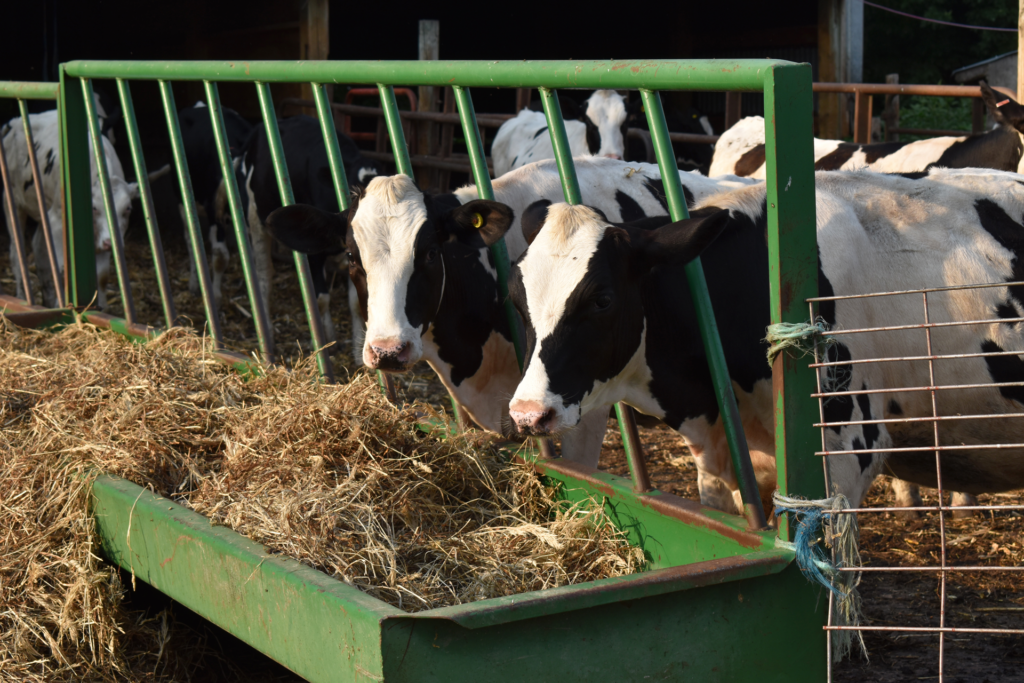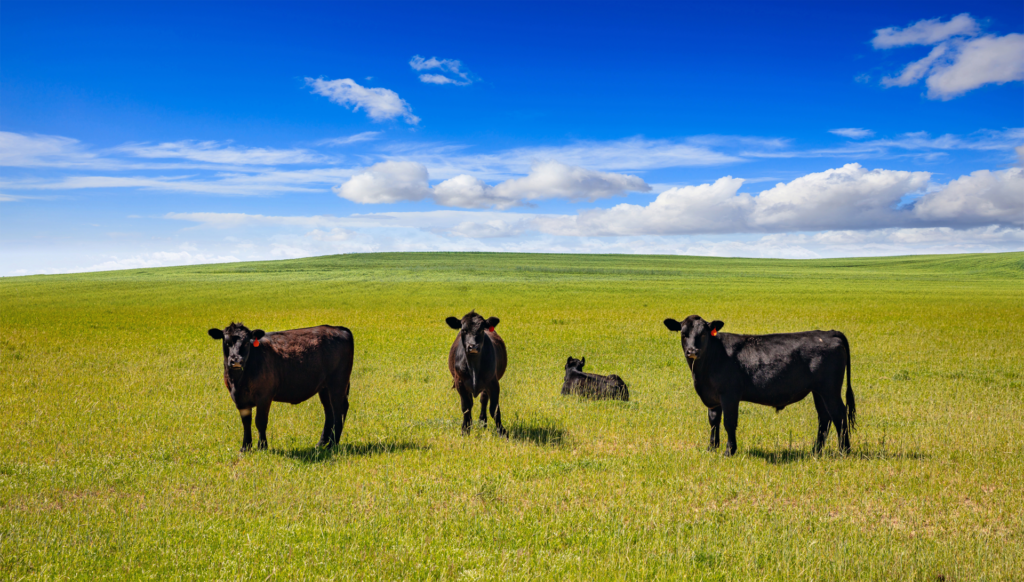Value-added programs help producers command a higher price for their products while also providing customers peace of mind about product quality and consistency. Value-added programs offer ranchers, growers, and other operators a great way to distinguish their products in the market and boost profitability.
Although these programs offer quite a bit of flexibility with the process points you choose for verification, it can get confusing and raise questions. For example, which value-added program is right for me? We break it all down here.

What Does “Value-Added” Mean?
Here is an example that can help clarify what it means to participate in a value-added program:
Say a rancher who raises black angus cattle wants to receive a premium price for their cattle at auction. Marketing their cattle as Age and Source Verified through a value-added program allows them to do that, which raises its value on the market.
However, the rancher must raise their cattle according to defined requirements, document the entire process, and pass an audit.
After successfully passing an audit, they can market their cattle as Age and Sourced Verified. The Age and Source Verification then follows these cattle through the feed yard, and if management practices continue to be followed, they can be processed, and end products marketed with this value-added claim.
This process provides the customer confidence that they are purchasing beef that meets specific quality requirements. That leads us into our next question:
How Do I Get Approval for a Value-Added Claim?
Continuing with our example above, the rancher must raise their cattle according to clearly defined, implemented, and transparent process points documented in a Quality Manual. Each process point must be…
- Supported by a documented management system
- Independently verified by a qualified value-added-claims auditor
Auditors begin with a desk audit to ensure all program requirements are accounted for and documented in the Quality Manual. Afterward, the auditor conducts a thorough on-site audit of all facilities and phases of the operation that affect process points.
In this case, the auditor must confirm practices and records for items such as animal identification, calving, shipping and receiving, employee training, and other internal management systems.
If the rancher’s process is successfully verified by the auditor, they will receive a certificate of approval. This certificate shows that their operation’s practices were in compliance with the claims of that value-added program.
What are the Value-Added Program Requirements?
Requirements for value-added programs vary depending on the industry and product. An operator can apply to have several different process points verified, including production practices; services; and various qualities of the product, such as age, size, breed, and more.
Certain value-added programs offer the flexibility to choose which process points are verified so operators can customize the program to fit their goals.
In whatever way an applicant sets up their value-added program, the point is to assure customers of their ability to provide high-quality products in a consistent manner. The process points defined for verification must be…
- Verifiable
- Repeatable
- Feasible
- Factual
- Cannot be requirements of regulations or management system criteria
The program is a win-win, giving customers peace of mind in what they are purchasing and helping producers receive a premium price for their products.
What are Some of the Value-Added Programs?
An operator can apply to have a variety of process points throughout their operation audited and verified. For example, a cattle rancher can have all process points related to the age and source of their cattle verified. They might also choose to verify that they do not treat their cattle with hormones
A poultry operator can apply to have a variety of process points for their operation verified, such as the fact that they do not use antibiotics or that their poultry is raised cage-free. Similar criteria exist for fruits, vegetables, nuts, and other commodities. The program offers plenty of flexibility so operators can tailor it to suit their goals.
That said, some of the more commonly used programs in the beef industry, which are audited by FSNS C&A, are discussed below:
- Age and Source Verification (ASV)
- Non-Hormone Treated Cattle (NHTC)
- Never Fed Beta Agonists
- High Quality Beef Livestock Feeding Claim (EU HBQ)
- Non-GMO
- Grass-Fed
- Natural Verified Beef
If you are new to value-added program requirements, this can seem daunting. A specialist with FSNS Certification & Audit can help walk you through the requirements for better understanding. Contact us with your questions about value-added programs today.

Age and Source Verification (ASV)
Consumers are taking a greater interest in the source of their food and basic food safety standards. Age and Source Verification is where many operators who are new to value-added programs start. It allows you to market your animals with the assurance of their age and source, putting customers at ease. This is typically done with an audit of birth records cross-referenced with a unique identifying ear tag.
There are a few different product requirements for age and source verification, but a few of the most notable are included here to give you an idea of the expectations:
- On-farm, cattle must be uniquely identified with a program compliant tag (PCT).
- Cattle must be tracked from birth.
- Cattle must be tagged before they can be moved off the ranch of origin.
Non-Hormone Treated Cattle (NHTC) Program
Exporting beef products to the European Union requires third-party verification that no hormonal growth promotants were used during the animal’s life. The NHTC cattle program was created to help U.S. beef producers meet the requirements and expand their marketability.
View the complete requirements for Non-Hormone Treated Cattle here. Highlights include the following:
- Animals cannot be administered hormonal growth promotants (HGPs) at any time during their lifetime.
- Animals must be traceable from their farm or ranch of birth using live animal production records.
- Animals must be obtained from, and must be traceable to, approved companies that appear on the “Official Listing of Approved Sources of Non-Hormone Treated Cattle”.
- Animals must be identified prior to leaving the place of birth with a program compliant ear tag.
- The company must maintain sufficient records of all rations fed to animals for the lifespan of the animal.
- Shipping documentation must accompany each shipment of animals that occurs due to sale or transfer of custody.
Never Fed Beta Agonists
Beta agonists are feed ingredients that help cattle gain muscle as they age and near harvest. They are non-steroidal growth promotants, which can increase feed conversion and allow cattle to gain weight more efficiently. Some consumers prefer an option raised without their use.
Operators can have their cattle or hogs verified as having never been fed beta agonists. As with other verifications, product requirements include a documented quality management system that allows products to be identified and traceable through the system.
Complete requirements for Never Fed Beta Agonists verification are here, but some highlights are provided below
- Establishments must develop a program to evaluate and approve suppliers of cattle or hogs that have never been fed beta agonists.
- Establishments must maintain an approved list of suppliers who have been verified as capable of supplying cattle or hogs that have never been fed beta agonists.
- Establishments must maintain controls to ensure the segregation of live animals that have been fed beta agonists from those that have not prior to harvest.
- Establishments must develop a verification testing regime using an approved test method based on a carcass sampling plan that ensures that each approved supplier is tested at least once per quarter.
- If meat from animals that were raised by an approved supplier produces a positive test result, that supplier and product must be excluded from the program until corrective actions have been implemented and verified.
High Quality Beef Livestock Feeding Claim (EU HQB) Quota A or Quota B
Some operators choose to market their beef with a feeding claim to receive a premium price, such as cattle being fed certain ingredients, a specific amount, or even being fed a unique ration for a certain number of days.
Some elect to verify a feeding claim that allows for eligibility to export to the European Union under the EU High Quality Beef Livestock Feeding Claim, which is broken down into Quota A and Quota B. This provides producers flexibility to verify the feeding claim that is best for their operation. You can find details of the High Quality Beef Livestock Feeding Claim (EU HQB) here, but the notable points are included below.
- A company may specify its own feed claim. If so, the following information must be provided:
- Ration
- Number of days on feed
- Rate of feed (lbs. per head per day)
- The European Union High Quality Beef Feeding Claim requires verifying different process points, including the following:
- Quota A: Cattle must have been fed for 100 days or more on a nutritionally balanced, high energy feed concentration ration containing no less than 70% grain, and at least 20 lbs. feed per day per head
- Quota B: Cattle must have been fed the last 100 days on a diet containing not less than 62% of concentrates and/or feed grain co-products on a dietary dry matter basis that meets or exceeds a metabolizable energy content greater than 12.26 mega joules per one kilogram of dry matter
- Beef must be obtained from cattle less than 30 months of age to ship under Quota B
- In addition to meeting quota requirements, cattle must also be sourced from an approved NHTC Program to be exported to the EU
If you need help understanding the requirements of these value-added programs, our livestock audit specialists are here to help.
Non-GMO
Some consumers avoid purchasing genetically modified organisms (GMOs), which include any organism whose genetic material has been modified using genetic engineering techniques. Wherever producers stand on the issue, having their cattle or other livestock verified as non-GMO can increase the value.
Verification as non-GMO indicates that cattle and their feed have been raised in a fashion that does not use GMOs and avoids cross-contamination. Various process points are audited to ensure cattle are raised without use of genetically modified products and that there is low risk of contamination.

Grass-Fed
Consumer demand continues to drive the need for grass-fed beef. Some meat eaters prefer grass-fed beef for its flavor profile and because it is generally leaner.
As such, it is not enough for most consumers if a producer simply claims their beef is grass-fed; the consumer desires third-party verification. Under a value-added program, beef growers and producers can apply to have their production process verified to show their cattle have been raised on a grass diet, which can include silage and hay in addition to grazed grass.
Cattle must be moved through approved Verified Grass-Fed locations to maintain eligibility.
Verified Natural Beef
Marketing your cattle as Verified Natural Beef requires third-party verification that the following criteria are met:
- No growth promotants
- No beta-agonists
- No antibiotics or sulfas
- No animal by-products
- No ionophores
Note that Verified Natural Beef cattle must be sold to an approved VNB location, otherwise they can lose their approval status since the buyer must be approved to purchase Verified Natural Beef cattle. As we’ve said, participating in a value-added program helps you command a higher price for your products.
Which Value-Added Program is Right for Me?
Third-party verification programs, like a value-added program, offer excellent ways to distinguish your products from the competition and get a higher price. Verifying against different claims carries different benefits and requirements. Some verifications require fewer steps and less work to achieve but offer less potential reward at sale time. Others require more effort but increase your profitability exponentially.
Our Certification & Audit Specialists can help you decide which is right for your operation. Discover new opportunities for your operation by contacting us now.




